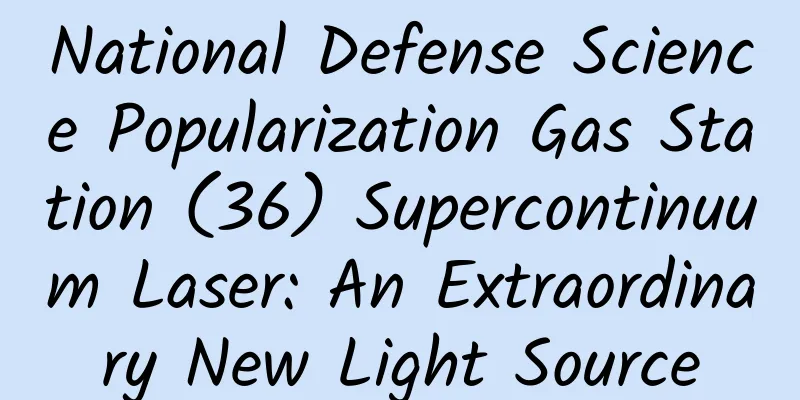National Defense Science Popularization Gas Station (36) Supercontinuum Laser: An Extraordinary New Light Source

|
In the field of optics, laser has the characteristics of high brightness, good monochromaticity, and good directionality. It is known as "the brightest light, the fastest knife, and the most accurate ruler." Its wide application has brought about a series of transformative innovations and creations, and promoted human scientific progress and economic and social development. It can be said that "the disciple surpasses the master". In 1970, 10 years after the birth of laser, a new laser light source, "supercontinuum laser", was born. This new member of the laser family is different from the general monochromatic (narrow spectrum) ordinary laser. It is a multicolor laser with an extremely wide spectrum. Its spectrum width is more than 100 nanometers, and can reach 5000 nanometers or even more than 10000 nanometers. This supercontinuum laser not only has all the characteristics of laser, but also has light source characteristics such as wide spectral range and good spatial coherence. Therefore, it has a wider range of applications and amazing development potential. Originated from laser, grown in the "fertile soil" of optical fiber Interestingly, the birth of supercontinuum laser actually "violates" the common sense and laws of linear optics. This is because the characteristic of supercontinuum laser is that it has a spectrum as wide as ordinary white light. In the theory of traditional linear optics, although white light can be decomposed into monochromatic light of various colors, a beam of monochromatic light cannot be directly converted into white light, that is, a supercontinuum (wide spectrum) light source cannot be obtained. Incredibly, in 1970, American scientists Arano and Shapiro injected a quasi-monochromatic green picosecond pulse laser into a solid nonlinear medium (a special optical glass), and unexpectedly obtained a 400-700 nanometer white light output. The monochromatic green light turned into a composite white light with a wide and continuous spectrum. This accidental scientific discovery quickly shocked the optical world, and since then, a new type of light source - supercontinuum laser was born! This scientific discovery seems accidental, but it is in line with the inevitable laws of science. The mechanism behind the generation of supercontinuum is the nonlinear interaction between strong laser and medium, that is, when one or more quasi-monochromatic strong laser "seeds" propagate in the "soil" of the medium (such as glass, gas, etc.), the electric field intensity of the light wave is sufficient to be comparable to the electric field inside the medium atoms. At this time, the interaction between the "seed" light and the medium "soil" produces a "nonlinear effect". This effect makes the spectrum of the original monochromatic laser expand to short waves and long waves like a "gene mutation". The newly generated spectral components will serve as new pump light and continuously expand to both sides. Finally, a narrow-band spectrum expands into an ultra-wide continuous spectrum, namely a supercontinuum. The "soil" for producing supercontinuum lasers in the early days was not ideal. It was mainly concentrated in conventional nonlinear media such as solids, gases and liquids. It not only required extremely high peak power incident laser "seeds", but also had large transmission losses and poor beam quality, making it difficult to meet application requirements. In the 1980s, the birth and application of low-loss optical fiber provided an excellent "fertile ground" for the generation and transmission of supercontinuum lasers. Optical fiber can confine lasers in a micrometer-sized optical fiber core, enhancing the nonlinear effect of the interaction between lasers and media. At the same time, it can also increase the transmission distance and improve the quality of the output beam. In 1996, researchers at the University of Southampton in the UK developed a photonic crystal fiber that is very suitable for supercontinuum generation. It has higher nonlinear coefficients and more flexible and adjustable dispersion characteristics, which is a milestone in the study of supercontinuum. Since then, the research and application of supercontinuum lasers have achieved rapid development. Nowadays, not only can supercontinuum spectra be generated in an increasing number of new optical fibers such as soft glass optical fibers and tapered optical fibers, scientists have also reduced the "soil" for supercontinuum generation to silicon-based waveguides such as silicon nitride, making them on-chip compatible with existing complementary metal oxide semiconductors (CMOS devices), which is expected to broaden the application of silicon-based photonics. Outstanding performance, all-in-one advantage As soon as the supercontinuum laser was born, it astonished the entire optical world with its unique light source characteristics. It not only has the characteristics of high laser brightness, strong coherence, and good directionality, but also has a wide spectrum performance similar to sunlight. The light is colorful. Supercontinuum lasers are often figuratively called white light lasers, but the wavelengths they cover are far more than white light in the visible light band. They have expanded from the earliest visible light band to the ultraviolet, near-infrared, mid-infrared and far-infrared bands. Supercontinuum lasers in different bands also have their own strengths in application. It can be said that supercontinuum lasers are a kind of multi-color light that is more colorful than white light. The spectrum range is wide and the brightness is high. Compared with the narrow spectrum characteristics of ordinary lasers, the spectrum of supercontinuum lasers is extremely wide and continuously broadened. The width is usually greater than 100 nanometers and can reach more than 10,000 nanometers. This wide spectrum advantage can cover many bands. Calculations have shown that, taking the common femtosecond supercontinuum light source with a peak power of gigawatts and a time domain repetition rate of kilohertz as an example, the laser power irradiated per unit area is more than 700 times the power density of solar radiation. The high brightness of supercontinuum lasers can be seen from this. The time domain is flexible and controllable. The pumping options for supercontinuum lasers include continuous wave lasers, nanosecond lasers, picosecond lasers, femtosecond lasers, etc., so that pump sources with different repetition frequencies and pulse widths can be selected according to different application requirements. For example, a supercontinuum light source with a high repetition frequency is required in optical fiber communications, and a supercontinuum light source with a pulse width of femtoseconds is generally used in optical coherence tomography technology. At the same time, by comprehensively adjusting the time domain parameters, it is also possible to achieve tailor-made supercontinuums with specific shapes and specific spectral widths. Amazing application potential, boosting military transformation As a major invention of the 20th century, laser has illuminated the entire human race since its birth. Supercontinuum lasers, which have superior performance than ordinary lasers, have broader application prospects. In the biomedical field, optical coherence tomography technology based on supercontinuum light sources can realize three-dimensional imaging and clinical diagnosis of living tissues such as retina and coronary artery; in the field of food safety, the absorption spectrum and transmission spectrum of the sample can be collected in a short time by irradiating the sample under test with a supercontinuum light source, realizing rapid inspection of food; in the field of communications, supercontinuum light sources can act as "transportation supermen" and are used in wavelength division multiplexing communication systems, becoming a timely rain in today's information age; in the field of imaging, supercontinuum light sources are illuminating objects as large as organs and as small as molecules, helping humans to explore the world more clearly. In the military field, supercontinuum light sources, due to their unique properties, have been developed and applied by the United States, Russia, France and other countries in optoelectronic confrontation, battlefield perception, military communications and other aspects, and are expected to bring transformative and far-reaching impacts. Optoelectronic countermeasures are superior. At present, the active infrared countermeasure method uses high-brightness infrared lasers to suppress and destroy enemy optoelectronic equipment, which is an important means to ensure the safety of aviation aircraft. Compared with optical parametric oscillators and quantum cascade lasers with single output wavelengths and difficult tuning, supercontinuum laser light sources have the inherent advantages of good spatial coherence and wide spectral range, and cannot be protected by narrow-band filtering and optical notching. In particular, supercontinuum light sources in the mid-infrared band (2500-5000 nanometers) can cover the typical working band of common infrared heat-seeking seekers, so that interference, saturation and blinding of enemy precision-guided weapons can be effectively achieved. At present, it is reported that the US military has installed a directional infrared countermeasure (DIRCM) system containing a mid-infrared supercontinuum light source on the bottom of large aircraft and helicopters, and equipped it with a rotating arm to scan suspicious targets around the aircraft, to interfere with the infrared-guided missile seeker, and ultimately deviate from the fixed trajectory and break away from the target. Battlefield perception will be more accurate. The broadband characteristics of supercontinuum can cover the absorption peaks of common gases (such as carbon dioxide, methane, ammonia, etc.), and realize synchronous, real-time, and remote monitoring of multiple gases. At the same time, the spatial coherence characteristics of supercontinuum light sources enable them to have a long interaction length with gas mixtures, which can significantly improve the detection sensitivity and realize the detection of extremely trace gas molecules. The Ilmenau University of Technology in Germany also uses supercontinuum lasers coupled with optical short-pass filters to simultaneously measure the temperature field and velocity field of atmospheric turbulence with a high spatial resolution, which is expected to help weather forecasts. In addition, active hyperspectral imaging technology using supercontinuum lasers as illumination sources has been applied to various detection tasks in developed countries such as the United States. Compared with traditional imaging illumination light, wide-spectrum supercontinuum lasers can continuously and actively illuminate targets at ultra-long distances, which is more helpful in identifying camouflaged targets, improving target recognition accuracy, and increasing the difficulty of enemy defense. In short, in the future, supercontinuum light sources will provide new solutions and technical means for troop operations, whether in battlefield environment reconnaissance or real-time meteorological support. Massive data can be transmitted faster. By cutting the supercontinuum light source through spectral filtering technology, any wavelength division multiplexing light source can be obtained in theory. This high repetition frequency, multi-wavelength coherent pulse light source is the key technology for realizing high-speed and large-capacity optical communication systems. Japan has been able to use supercontinuum light sources to generate multi-wavelength light sources with 1064 channels, thereby achieving high-speed fiber-optic communication of 2.7 terabits per second (1 terabit is equivalent to 10244 bits). A supercontinuum light source can replace thousands of ordinary laser light sources with one, which will provide high-speed and compact technical support for information-based joint operations that require the transmission of massive data. In the field of free space communication, a research team has proved that the use of supercontinuum light sources as partially coherent high-speed carriers can effectively suppress the light intensity flicker caused by atmospheric turbulence, and achieve a communication rate of 16 gigabits per second (1 gigabit is equivalent to 10243 bits). In the future, if space communication technology based on supercontinuum light sources is used as a battlefield emergency communication solution, it will be more handy when applied to emergencies, local wars and other situations. With the advancement of technology and the improvement of process level, supercontinuum lasers will develop towards higher average power, wider spectrum width and better beam quality in the future. This extraordinary new light source is bound to play a huge role in driving innovation and achieve more unimaginable achievements. (Author: Wang Wuwen, Zhu Xiran Source: National University of Defense Technology Science Popularization China Co-construction Base) |
<<: There are bite marks on the shit. Who is so hungry?
>>: When will household solar power generation say goodbye to “polarization”?
Recommend
Enjoy the spring, learn about this flower viewing guide
March is the season of spring, and the weather is...
Nielsen: 2022 Chinese Women's Auto Consumption Trend Report
The "China Women's Automobile Consumptio...
World No Tobacco Day丨What will happen if you smoke for more than 15 years?
Today is the 35th World No Tobacco Day. The theme...
An 800-year-old underwater blind box
35th Anniversary of the Discovery of Nanhai I Spe...
A Rough Guy - Advanced Chest Training
A rough man-chest training advanced resource intr...
Ogilvy's internal training on advertising creativity
In "Creativity is just incomprehensible? In ...
The "Color Business Practice Course" not only teaches you how to match colors, but also covers all color issues in one go!
Course Catalog [Promotional Video] More than just ...
First confirmed! This part of the human body evolved from fish gills
The international academic journal "Frontier...
Dr. Huang's Three Strength Courses
Introduction to Dr. Huang’s three major strength ...
Jintan SEO Training: Revealing the three reasons why keyword rankings cannot be improved
It is not uncommon to hear SEO practitioners refl...
Reverse time and rejuvenate! Is the Turritopsis immortal?
References: 1. "On the list of longevity ani...
International Day Against Drug Abuse and Illicit Trafficking丨Reject “drugs come and go”, don’t let the alarm bells ring in vain
As the country's drug control efforts continu...
China Association of Automobile Manufacturers: Brief analysis of automobile industry production and sales in July 2023
According to statistics and analysis by the China...
China Automobile Dealers Association: In-depth analysis of the national used car market in September 2021
01. Market Overview in September 2021 In Septembe...
10 basic skills necessary for operating Douyin
Douyin became a huge hit like a bolt from the blu...









